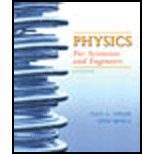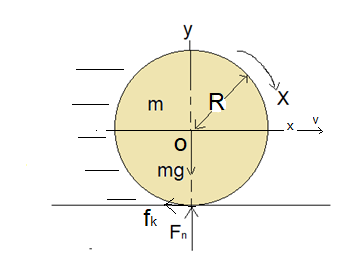
Concept explainers
(a)
The speed of the ball as it begins rolling without slipping.
(a)
Answer to Problem 107P
Explanation of Solution
Given:
Radius of the ball is
Initial speed of the ball is
The coefficient of kinetic friction between the ball and billiard table is
Forward spin of the ball just after its release is
Formula Used:

FIGURE: 1
Constant acceleration equation that relates the speed of the ball to the acceleration and time,
Where,
Referring to the force diagram shown in figure 1, applying Newton’s second law to the ball when it is rolling without slipping,
And
Where,
Calculation:
Where,
From equation
Substituting this in equation
Now,substituting the expression for
Substituting for
From equation
Moment of inertia with respect to an axis through the center of the ball is
Substituting for
Now let us write constant-acceleration equation that connects angular speed of the ball to the angular acceleration and time,
Imposing the condition for rolling the ball without slipping,
Substituting for
Now equate the equations
Substituting this
Conclusion:
The speed of the ball as it begins rolling without slipping is
(b)
The time the ball moves before it begins to rolling without slipping .
(b)
Answer to Problem 107P
Explanation of Solution
Given:
Radius of the ball is
Initial speed of the ball is
The coefficient of kinetic friction between the ball and billiard table is
Forward spin of the ball just after its release is
Formula Used:

FIGURE: 2
Constant acceleration equation that relates the speed of the ball to the acceleration and time,
Where,
Referring to the force diagram shown in figure 2, applying Newton’s second law to the ball when it is rolling without slipping,
And
Where,
Calculation:
Where,
From equation
Substituting this in equation
Now,substituting the expression for
Substituting for
From equation
Moment of inertia with respect to an axis through the center of the ball is
Substituting for
Now let us write constant-acceleration equation that connects angular speed of the ball to the angular acceleration and time,
Imposing the condition for rolling the ball without slipping,
Substituting for
Now equate the equations
Conclusion:
The time the ball moves before it begins to rolling without slipping
(c)
The distance slide down the lane by the ball before it begins rolling without slipping.
(c)
Answer to Problem 107P
Explanation of Solution
Given:
Radius of the ball is
Initial speed of the ball is
The coefficient of kinetic friction between the ball and billiard table is
Forward spin of the ball just after its release is
Calculation:
Let
Now let us write expression that relates
Average speed of the ball is,
Substituting this average speed in equation
Substituting for
Conclusion:
The distance slide down the lane by the ball before it begins rolling without slipping is
Want to see more full solutions like this?
Chapter 9 Solutions
Physics for Scientists and Engineers, Vol. 1
- In testing an automobile tire for proper alignment, a technicianmarks a spot on the tire 0.200 m from the center. He then mountsthe tire in a vertical plane and notes that the radius vector to thespot is at an angle of 35.0 with the horizontal. Starting from rest,the tire is spun rapidly with a constant angular acceleration of 3.00 rad/s2. a. What is the angular speed of the wheel after 4.00 s? b. What is the tangential speed of the spot after 4.00 s? c. What is the magnitude of the total accleration of the spot after 4.00 s?" d. What is the angular position of the spot after 4.00 s?arrow_forwardA disk 8.00 cm in radius rotates at a constant rate of 1200 rev/min about its central axis. Determine (a) its angular speed in radians per second, (b) the tangential speed at a point 3.00 cm from its center, (c) the radial acceleration of a point on the rim, and (d) the total distance a point on the rim moves in 2.00 s.arrow_forwardThe propeller of an aircraft accelerates from rest with an angular acceleration = 4t + 6, where is in rad/s2 and t isin seconds. What is the angle in radians through which thepropeller rotates from t = 1.00 s to t = 6.00 s?arrow_forward
- A solid cylinder of mass 2.0 kg and radius 20 cm is rotating counterclockwise around a vertical axis through its center at 600 rev/min. A second solid cylinder of the same mass and radius is rotating clockwise around the same vertical axis at 900 rev/min. If the cylinders couple so that they rotate about the same vertical axis, what is the angular velocity of the combination?arrow_forwardA point on a rotating turntable 20.0 cm from the center accelerates from rest to a final speed of 0.700 m/s in 1.75 s. At t = 1.25 s, find the magnitude and direction of (a) the radial acceleration, (b) the tangential acceleration, and (c) the total acceleration of the point.arrow_forwardJeff, running outside to play, pushes on a swinging door, causing its motion to be briefly described by = t2 + 0.800 t + 2.00,where t is in seconds and is in radians. At t = 0 and at t = 1.50s, what are the a. angular position, b. angular speed, and c. angularacceleration of the door?arrow_forward
- The velocity of a particle of mass m = 2.00 kg is given by v= 5.10 + 2.40 m /s. What is the angular momentumof the particle around the origin when it is located atr= 8.60 3.70 m?arrow_forwardA thin rod of length 2.65 m and mass 13.7 kg is rotated at anangular speed of 3.89 rad/s around an axis perpendicular to therod and through its center of mass. Find the magnitude of therods angular momentum.arrow_forwardWhy is the following situation impossible? A space station shaped like a giant wheel has a radius of r = 100 m and a moment of inertia of 5.00 108 kg m2. A crew of 150 people of average mass 65.0 kg is living on the rim, and the stations rotation causes the crew to experience an apparent free-fall acceleration of g (Fig. P10.52). A research technician is assigned to perform an experiment in which a ball is dropped at the rim of the station every 15 minutes and the time interval for the ball to drop a given distance is measured as a test to make sure the apparent value of g is correctly maintained. One evening, 100 average people move to the center of the station for a union meeting. The research technician, who has already been performing his experiment for an hour before the meeting, is disappointed that he cannot attend the meeting, and his mood sours even further by his boring experiment in which every time interval for the dropped ball is identical for the entire evening.arrow_forward
- A uniform rod of length b stands vertically upright on a rough floor and then tips over. What is the rods angular velocity when it hits the floor?arrow_forwardA system of point particles is rotating about a fixed axis at 4 rev/s. The particles are fixed with respect to each other. The masses and distances to the axis of the point particles are m1=0.1kg , r1=0.2m , m2=0.05kg , r2=0.4m , m3=0.5kg , r3=0.01m . (a) What is the moment of inertia of the system? (b) What is the rotational kinetic energy of the system?arrow_forwardLara is running just outside the circumference of a carousel, looking for her favorite horse to ride, with a constant angular speed of 1.00 rad/s. Just as she spots the horse, one-fourth of the circumference ahead of her, the carousel begins to move, accelerating from rest at 0.050 rad/s2. a. Taking the time when the carousel begins to move as t = 0, when will Lara catch up to the horse? b. Lara mistakenly passes the horse and keeps running at constant angular speed. If the carousel continues to accelerate at the same rate, when will the horse draw even with Lara again?arrow_forward
 Principles of Physics: A Calculus-Based TextPhysicsISBN:9781133104261Author:Raymond A. Serway, John W. JewettPublisher:Cengage Learning
Principles of Physics: A Calculus-Based TextPhysicsISBN:9781133104261Author:Raymond A. Serway, John W. JewettPublisher:Cengage Learning College PhysicsPhysicsISBN:9781305952300Author:Raymond A. Serway, Chris VuillePublisher:Cengage Learning
College PhysicsPhysicsISBN:9781305952300Author:Raymond A. Serway, Chris VuillePublisher:Cengage Learning Physics for Scientists and Engineers: Foundations...PhysicsISBN:9781133939146Author:Katz, Debora M.Publisher:Cengage Learning
Physics for Scientists and Engineers: Foundations...PhysicsISBN:9781133939146Author:Katz, Debora M.Publisher:Cengage Learning University Physics Volume 1PhysicsISBN:9781938168277Author:William Moebs, Samuel J. Ling, Jeff SannyPublisher:OpenStax - Rice University
University Physics Volume 1PhysicsISBN:9781938168277Author:William Moebs, Samuel J. Ling, Jeff SannyPublisher:OpenStax - Rice University Glencoe Physics: Principles and Problems, Student...PhysicsISBN:9780078807213Author:Paul W. ZitzewitzPublisher:Glencoe/McGraw-Hill
Glencoe Physics: Principles and Problems, Student...PhysicsISBN:9780078807213Author:Paul W. ZitzewitzPublisher:Glencoe/McGraw-Hill Physics for Scientists and Engineers, Technology ...PhysicsISBN:9781305116399Author:Raymond A. Serway, John W. JewettPublisher:Cengage Learning
Physics for Scientists and Engineers, Technology ...PhysicsISBN:9781305116399Author:Raymond A. Serway, John W. JewettPublisher:Cengage Learning





